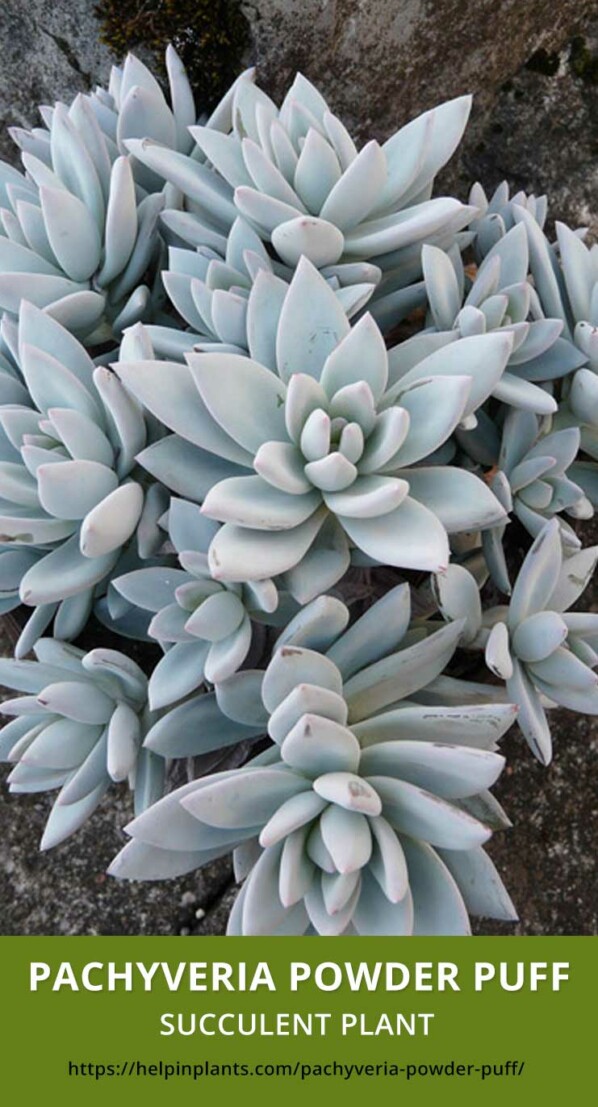Known as Exotica or Kobayashi
Pachyveria Powder Puff
Pachyveria Powder Puff is a hybrid succulent plant species obtained from Pachyphytum Oviferum and Echeveria Cante. Its leaves look powdery and silvery-blue color.
If exposed to strong light or cold temperature the color blush violet. During the summer months, the plant forms an arching raceme of small, bell-shaped, apricot flowers.
Details about Pachyveria Powder Puff "Known as Exotica or Kobayashi"
How to care for Pachyveria Powder Puff
Pachyveria Powder Puff is a hybrid of two other plants, Pachphytum Oviferum and Echeveria Cante. This succulent plant has beautiful powdery, silvery-blue leaves that blush violet in cold temperature or intense light. It is a good succulent plant to grow, especially for beginners. Because this can survive in many environmental and growing conditions.
Where to plant Pachyveria Powder Puff?
Generally, if you live in a colder environment. I.e. where temperature can go below 20 °F (-6 °C), you should plant this succulent in a container pot. Because it is not cold hardy, and you should be able to bring it inside.
It is also advised to not expose this plant to an environment where temperature can go below 7 °C, for a long time. Because it dies in a colder environment.
If your environment is not that cold, then it is best to plant this succulent in an outdoor garden. Because it'll grow healthier if it gets full sun for 4 to 6 hours a day.
Although, the Pachyveria as a whole are light-loving plants but protect them from too much direct sunlight by some shade.
Pachyveria Powder Puff is perfect for the rock garden or hanging basket and it looks gorgeous in a succulents container arrangement.
How to water Pachyveria Powder Puff?
Pachyveria Powder Puff does not require any special watering methods. Just use the normal succulent watering method. I.e. soak the soil completely, and then wait for some days to dry out completely before watering again. This method will help it develop stronger roots distribution.
In winter, it'll need frequent watering and well-draining soil. Because winter is the active growth season for Pachyveria Powder Puff. But the watering rules still apply here. Just make sure to not water if the soil is still wet.
Keep in mind, Pachyveria Powder Puff can withstand under watering but will die soon if overwatered.
How to Propagate Pachyveria Powder Puff
Pachyveria Powder Puff can be very easily propagated through its leaves and stem cuttings.
Propagation by Leaves
Propagating by leaves is the recommended method to follow for Pachyveria Powder Puff. Because it works extremely well.
When cutting a leaf for propagation, try to gently cut as a whole. I.e. no part of the leaf should be left on the stem. This will increase your chances of successful propagation.
It also drops leaves by itself from time to time. You can collect those dropped leaves as well to propagate.
After collecting leaves, callous over for a day or two. Then place the leaves on well-draining DIY soil OR get a pre-mixed succulents soil.
Propagation by Stem Cuttings
To propagate by stem cuttings, cut a stem from the main plant. Allow the removed stem to callous over for some days. Then place the stem in well-draining soil. The soil conditions can be poor but should be well-draining.
Remember to give water when the soil is completely dry. I have mentioned that at the last in how to water succulents guide. Click here to read that guide.
Pairs Well With
Echeveria runyonii 'Topsy Turvy'
Where to get this succulent plant?
You can buy the pachyveria powder puff succulent from:
Facts & Features
-
6 inches Tall
This plant grows up to 6″ (15 cm) tall
-
Grows in Winter
Need more care during this time.
-
Indoors Lit Area
Better to keep it near a window where it gets enough sunlight. OR, keep it outdoors.
-
Non Toxic
It's safe for humans and pets.
-
Normal Watering
Use regular succulent watering methods. Learn how to water succulents easily.
-
Not Cold Hardy
Protect from very low temperatures.
-
Partially Shady Sunlight
You can keep it in full sun but protect it during the afternoon.
-
Propagation by cuttings
Usually by a leaf or stem cutting.
-
Zone 9a
In this zone, the temperature can drop up to 20° F ( -6.7° C )

